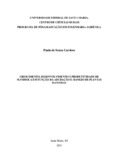| dc.creator | Cardoso, Paula de Souza | |
| dc.date.accessioned | 2021-12-06T13:45:51Z | |
| dc.date.available | 2021-12-06T13:45:51Z | |
| dc.date.issued | 2021-02-11 | |
| dc.identifier.uri | http://repositorio.ufsm.br/handle/1/23158 | |
| dc.description.abstract | The increase in the world population, which may exceed 10 billion in 2050, will require low-cost and easy production. As a result, cassava (Manihot esculenta Crantz) was chosen by the UN as the 21st century crop. The objective of this study was to verify the influence of fertilization and the period of weed control on the growth and development of the cassava crop, and to determine a morphological indicator to identify the beginning of starch accumulation (BSA) and the yield in cassava cultivars. Two studies were carried out, the first was conducted in cassava field in Ibarama and Santa Maria in Rio Grande do Sul in 2018/2019 representing the management practices carried out by farmers such as the fertilizer amount and weed control. The second study was carried out in Santa Maria in the 2018/2019 and 2019/2020 growing season in order to determine the number of leaves at the beginning of starch accumulation and the yield of seven registered and unregistered cassava cultivars. The yield of tuberous roots when fertilizing and controlling weeds was 43.5 Mg ha-¹, reaching 80% of the yield potential, besides of the 50% increase the accumulation in shoot dry matter. BSA can be identified by the morphological indicator number of leaves, ranging from 24 leaves in IAC 576 cultivar to 33 leaves in Fepagro RS13 cultivar. | eng |
| dc.language | por | por |
| dc.publisher | Universidade Federal de Santa Maria | por |
| dc.rights | Attribution-NonCommercial-NoDerivatives 4.0 International | * |
| dc.rights.uri | http://creativecommons.org/licenses/by-nc-nd/4.0/ | * |
| dc.subject | Manihot esculenta Crantz | por |
| dc.subject | Fertilidade | por |
| dc.subject | Capinas | por |
| dc.subject | IAA | por |
| dc.subject | Produtividade | por |
| dc.subject | Fertility | eng |
| dc.subject | Weeding | eng |
| dc.subject | BSA | eng |
| dc.subject | Productivity | eng |
| dc.title | Crescimento, desenvolvimento e produtividade de mandioca em função da adubação e manejo de plantas daninhas | por |
| dc.title.alternative | Growth, development and yield of cassava as a function of fertilization and weed management | eng |
| dc.type | Dissertação | por |
| dc.description.resumo | O aumento da população mundial, que poderá exceder 10 bilhões em 2050, exigirá a produção de alimentos de baixo custo e fácil produção. Em virtude disso, a mandioca (Manihot esculenta Crantz) foi eleita pela ONU a cultura do século XXI. O objetivo desse estudo foi verificar a influência da adubação e o período de controle de plantas daninhas no crescimento e desenvolvimento da cultura da mandioca, e determinar um indicador morfológico para identificar o início da acumulação de amido (IAA) e a produtividade em cultivares de mandioca. Foram realizados dois estudos, o primeiro foi conduzido em lavouras de mandioca em Ibarama e Santa Maria no Rio Grande do Sul em 2018/2019 representando as práticas de manejo realizadas pelos agricultores como a quantidade de fertilizantes e o controle de plantas daninhas. O segundo estudo foi realizado em Santa Maria nos anos agrícolas 2018/2019 e 2019/2020 com o objetivo de determinar o número de folhas no início de acumulação de amido e a produtividade de sete cultivares registradas e não registradas de mandioca. A produtividade de raízes tuberosas quando realizado a adubação e controle de plantas daninhas foi de 43,5 Mg ha-¹, atingindo 80% do potencial de produtividade, além do aumento no acúmulo de matéria seca de parte área em 50%. O IAA pode ser identificado pelo indicador morfológico número de folhas, variando de 24 folhas na cultivar IAC 576 até 33 folhas na cultivar Fepagro RS13. | por |
| dc.contributor.advisor1 | Zanon, Alencar Junior | |
| dc.contributor.advisor1Lattes | http://lattes.cnpq.br/7337698178327854 | por |
| dc.contributor.advisor-co1 | Streck, Nereu Augusto | |
| dc.contributor.advisor-co1Lattes | http://lattes.cnpq.br/8121082379157248 | por |
| dc.contributor.referee1 | Ulguim, André da Rosa | |
| dc.contributor.referee2 | Tironi, Luana Fernandes | |
| dc.creator.Lattes | http://lattes.cnpq.br/1330757552136903 | por |
| dc.publisher.country | Brasil | por |
| dc.publisher.department | Engenharia Agrícola | por |
| dc.publisher.initials | UFSM | por |
| dc.publisher.program | Programa de Pós-Graduação em Engenharia Agrícola | por |
| dc.subject.cnpq | CNPQ::CIENCIAS AGRARIAS::ENGENHARIA AGRICOLA | por |
| dc.publisher.unidade | Centro de Ciências Rurais | por |



